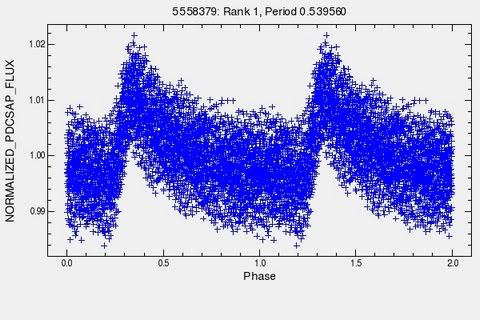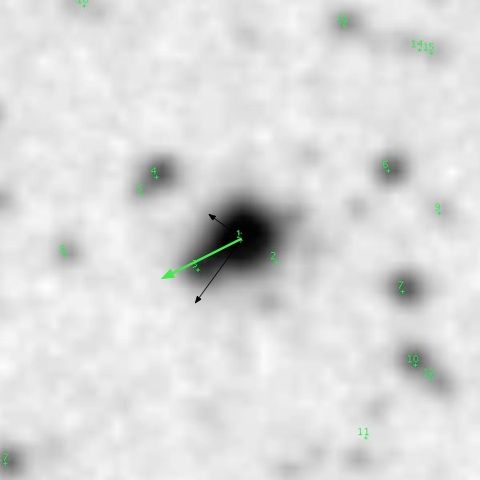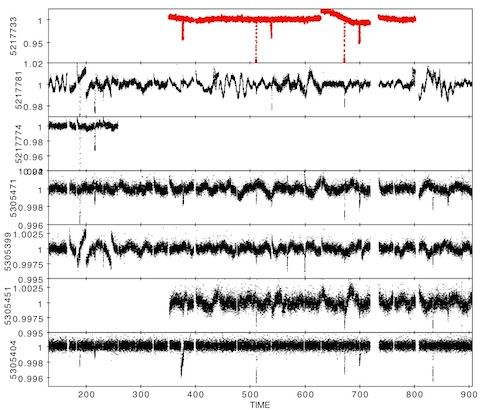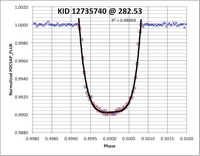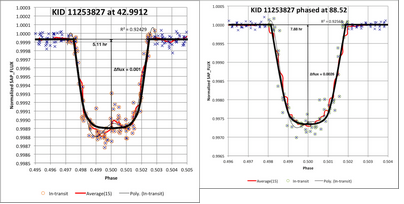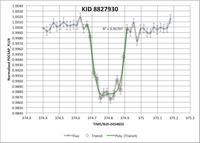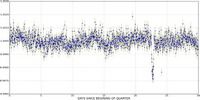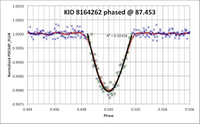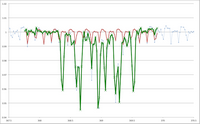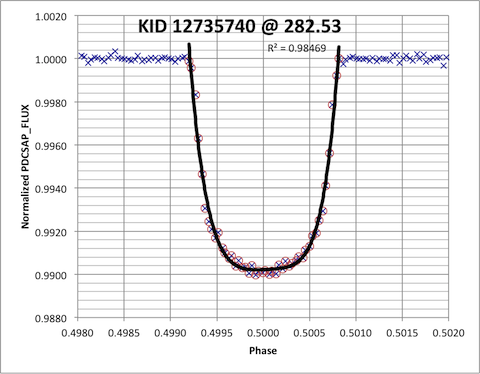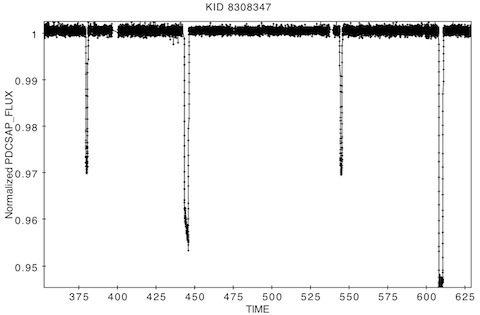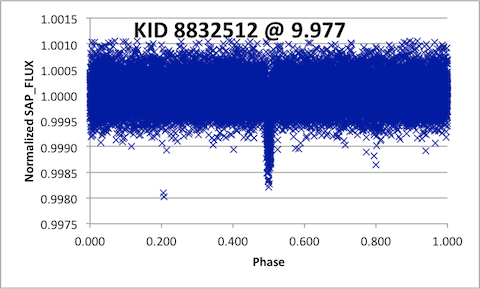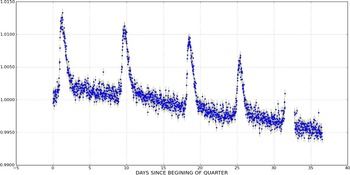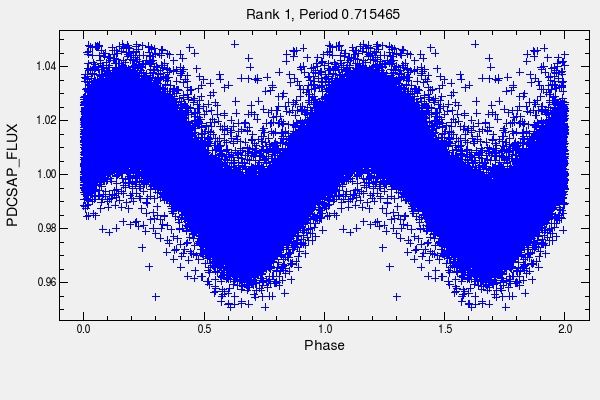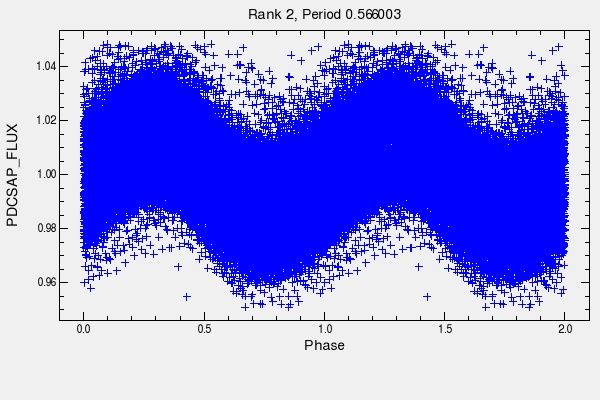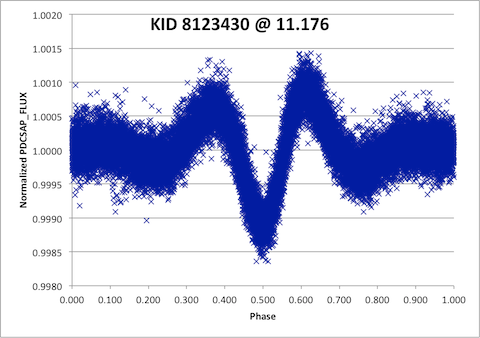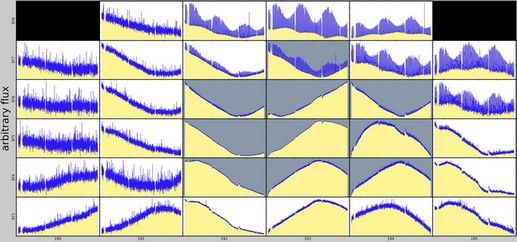This Kepler light curve for star KID 5558379 is being contaminated by an unlisted background RR Lyrae ( BG RRL) star. The phased curve cue for a possible RRL is shown below:
In this case, the star does not completely own its phased curve and is being contaminated from the BG RRL that is star KIC 5558387. Here is Kian Jek's comment:
"The APOs are significant, 5 and -10 millipixels, and the vector
(brightening) points unambiguously to #3 KIC 5558387 as the source of
the RRL-like pulsations. Unfortunately we don't know much about this
star."
More information on the Talk thread here.
Resurvey of Legacy Kepler Short and Long Cadence Light Curves
Tuesday, July 31, 2012
KID 5217733 Eclipsing Binary Super Contaminator
One of the obstacles to analyzing Kepler light curves is ruling out light contamination in the target star from background stars. Background eclipsing binary stars (BG EBs) are a real problem. KID 5217733 is a detached eclipsing binary star system with a magnitude of 7.4. This is a very bright star and as Kian Jek says, is a "Super Contaminator" affecting many nearby stars in the area.
Read more on this star on the Talk thread here.
Sunday, July 29, 2012
Hauling In The Nets On Kepler Q7 - Q9
No matter how many light curves we sift through in Classify or on the PH Talk forum it never gets old-- there is always something challenging to figure out waiting around the corner, and the past several days have been no exception to that rule. In addition to a host of new exoplanetary and binary star system candidates--some of which I'll highlight here--we've run into fresh new mysteries that will no doubt help keep everyone quite busy while we wait for the next public data release, and eventually the end of the proprietary period altogether as the extended mission proceeds.
Even with Kepler's exquisite light curve data quality, there are many considerations that could subsequently invalidate any of these suspected new objects, from blended background sources and astrophysical artifacts to software or hardware introduced issues. But we're confident many of them will hold up to future follow up performed by the scientific community in the months and years to come.
It's also quite possible that with the the imminent release of a new Kepler Object of Interest catalog, some will immediately turn out to be co-discoveries made alongside our friends around the world with the big scopes; nonetheless it's a powerful testament to the skill of the human eye, and to good old fashioned teamwork!
Potential Exoplanet Candidates
KID 7826659
Possible 6.7xRe Habitable Zone Candidate with Period of ~211 days
KID 12735740
Possible 1.1xRj Habitable Zone Candidate with Period of ~282 days
Possible Multplanetary System w/ a 4.0xRe at Period of ~42 days and a 6.49xRe at Period of ~88 days
KID 8827930
Possible 0.78xRj Candidate with a tentative Period of ~288 days
KID 5649325
Possible 0.96xRj Candidate with a Period of ~195 days
KID 11716643
Possible 3.8xRe Candidate with a tentative Period of ~466 days
Potential Stellar Companion Objects / Trinary Systems
KID 8164262
KID 6964043
KID 2856960
Probable Detached Eclipsing Binaries
KIDs
6756202, P= ~292
7674050, P= ~472
4586468, P= ~506
7117003, P= ~429
10074700, P= ~365
4663623, P= ~359
7431665, P= ~280
A big Thanks to everyone who took time out of their day (or night, as the case may be) to do some cross-checking and vetting with us this weekend!
KID 12735740 Possible Planet in Habitable Zone

Two transits for KID 12735740/ APH41073743 have been observed by Planet Hunters Talk members, up through quarter nine of the public data released by Kepler. Here is Kian Jek's comment:
"Just two transits so far but they stack so beautifully. Not only that, the profile is probably looking more like a PC (Planet Candidate) than an EB (Eclipsing Binary). Estimated 1.12x RJ planet at 0.862AU. With a Teq of 292K, it's in the HZ!"
Labels:
Exoplanet,
Exoplanet in habitable zone,
Kepler,
Kepler Light Curves,
KID 12735740,
Planet Hunters
Saturday, July 28, 2012
Amateur Kepler Observatory (AKO) at Planet Hunters
Planet Hunters forum Talk member troyw has developed a novel program for analyzing Kepler light curves called the Amateur Kepler Observatory (AKO). Here is his introductory comment:
"AKO is web based software continually developed for viewing data from the Kepler Space Telescope. AKO is currently limited to long cadence data. AKO reads the data entered into its database and sorts that data in a specific way. The data is sorted into rows and columns, and each data point is represented by a grey colored box, usually 3 pixels by 3 pixels, on a dynamically generated image."
More detailed information here.
Troy has a thread on the Planet Hunters Science board called "AKO possible discoveries". Here is an example of an AKO graph for KID 11853878 / KOI 1833 - two possible planet additions.
referenced here.

"AKO is web based software continually developed for viewing data from the Kepler Space Telescope. AKO is currently limited to long cadence data. AKO reads the data entered into its database and sorts that data in a specific way. The data is sorted into rows and columns, and each data point is represented by a grey colored box, usually 3 pixels by 3 pixels, on a dynamically generated image."
More detailed information here.
Troy has a thread on the Planet Hunters Science board called "AKO possible discoveries". Here is an example of an AKO graph for KID 11853878 / KOI 1833 - two possible planet additions.
referenced here.

The black horizontal lines are indications of a planet transit. One of the unique aspects of AKO is looking for Transit Timing Variations (TTVs) in the Kepler data for exoplanets. This is performed by stacking multiple quarters of the star's light curves.
Friday, July 27, 2012
Possible Trinary Star System KID 10091110
Possible Trinary Star system with great analysis by Talk members at Planet Hunters for KID 10091110 / APH51954360:
The Talk thread is well worth your time. Here is Kian Jek's comment:
"I don't think we're disputing that it's a circumbinary, but rather that it's a trinary, the third object isn't planetary, but most likely stellar - and from the 2:1 resonance seen, we just think it's very unlikely to be a blended BG EB. The Skyview doesn't show any elongated object, so if there is a blend, the 3rd light contaminant has to be very close, within 1-2" of the target.
Anyways, I've done a TTV analysis of the 3rd, 8.53d period eclipse. What I did was to take the first observed eclipse, treat this as T0, compute future eclipse timings from this and compare with each succeeding observed eclipse extremum. i.e. a straightforward O-C analysis. Here's my preliminary results. I think the picture tells a thousand words, no?
It looks like the minimum of each eclipse is arriving successively slower and then later. And it's not a trivial difference either - they are on the order of about 14 minutes earlier and later. After every tenth eclipse or so, it changes by double this amount and then reverts to the 14 minute interval again. I'm guessing the source of this third eclipse is therefore physically bound to this system.
Unless of course, it is from a blended EB, which itself has another 3rd object that is causing the TTVs of the blended eclipse. I think a certain William of Ockham would have some objections to that hypothesis..."
Jerry Orosz, Associate Professor, Department of Astronomy San Diego State University makes this comment:
"I think this is a blend of two unrelated EBs. There are two distinct periods in the light curve. There is an Algol-type light curve with a period of 4.21850952 days. The primary eclipse is a little over 2% deep, and the secondary eclipse (which appears at phase 0.5) is about 0.2% deep. The second signal has a period of 8.52998265 days, and only one eclipse is evident when phased at this period. The primary eclipse is nearly the same depth as the primary eclipse in the other light curve.
We often see light curves with only one eclipse per cycle. If the orbit is eccentric, the secondary eclipse can be missed. In the case of the longer period EB, it could be eccentric. If not, then we have a binary with twice that period where the two stars are equal, and the orbit is circular. One would need radial velocity measurements to be sure. I don't think these EBs are related since the respective O-C diagrams don't show any signals."
The Talk thread is well worth your time. Here is Kian Jek's comment:
"I don't think we're disputing that it's a circumbinary, but rather that it's a trinary, the third object isn't planetary, but most likely stellar - and from the 2:1 resonance seen, we just think it's very unlikely to be a blended BG EB. The Skyview doesn't show any elongated object, so if there is a blend, the 3rd light contaminant has to be very close, within 1-2" of the target.
Anyways, I've done a TTV analysis of the 3rd, 8.53d period eclipse. What I did was to take the first observed eclipse, treat this as T0, compute future eclipse timings from this and compare with each succeeding observed eclipse extremum. i.e. a straightforward O-C analysis. Here's my preliminary results. I think the picture tells a thousand words, no?
It looks like the minimum of each eclipse is arriving successively slower and then later. And it's not a trivial difference either - they are on the order of about 14 minutes earlier and later. After every tenth eclipse or so, it changes by double this amount and then reverts to the 14 minute interval again. I'm guessing the source of this third eclipse is therefore physically bound to this system.
Unless of course, it is from a blended EB, which itself has another 3rd object that is causing the TTVs of the blended eclipse. I think a certain William of Ockham would have some objections to that hypothesis..."
Jerry Orosz, Associate Professor, Department of Astronomy San Diego State University makes this comment:
"I think this is a blend of two unrelated EBs. There are two distinct periods in the light curve. There is an Algol-type light curve with a period of 4.21850952 days. The primary eclipse is a little over 2% deep, and the secondary eclipse (which appears at phase 0.5) is about 0.2% deep. The second signal has a period of 8.52998265 days, and only one eclipse is evident when phased at this period. The primary eclipse is nearly the same depth as the primary eclipse in the other light curve.
We often see light curves with only one eclipse per cycle. If the orbit is eccentric, the secondary eclipse can be missed. In the case of the longer period EB, it could be eccentric. If not, then we have a binary with twice that period where the two stars are equal, and the orbit is circular. One would need radial velocity measurements to be sure. I don't think these EBs are related since the respective O-C diagrams don't show any signals."
Wednesday, July 25, 2012
Tuesday, July 24, 2012
Dwarf Novae Candidates at Planet Hunters KIC 11412044, KIC 5565606, KID 10678185
Comment by Kian Jek:
"So far, Planet Hunters have found three background dwarf novae (DN) candidates in the Kepler public data, and we have worked out some basic characterizations of their properties as well as locations:
KIC 11412044 (see here)
KIC 5565606 (see here)
KIC 10678168 (see here) - the actual DN is suspected to be KIC 10678185
These were discovered at various times in the past with various contributions from many of us - I am just summarizing these here (on 6/30/2012) in the expectation that anybody trying to do a Google search of any of these Kepler IDs will be directed to this thread and continue to the discussions. If you have found these stars independently and plan to conduct some research on them, I simply request that you acknowledge our prior work and contributions. Please send correspondence to Meg Schwamb <megan.schwamb AT yale.edu>"
KIC 11412044
KIC 5565606
"So far, Planet Hunters have found three background dwarf novae (DN) candidates in the Kepler public data, and we have worked out some basic characterizations of their properties as well as locations:
KIC 11412044 (see here)
KIC 5565606 (see here)
KIC 10678168 (see here) - the actual DN is suspected to be KIC 10678185
These were discovered at various times in the past with various contributions from many of us - I am just summarizing these here (on 6/30/2012) in the expectation that anybody trying to do a Google search of any of these Kepler IDs will be directed to this thread and continue to the discussions. If you have found these stars independently and plan to conduct some research on them, I simply request that you acknowledge our prior work and contributions. Please send correspondence to Meg Schwamb <megan.schwamb AT yale.edu>"
KIC 11412044
KIC 5565606
KIC 10678168 contaminated by suspected DN KID 10678185
Labels:
Dwarf Nova,
Kepler,
Kepler Light Curves,
KID 10678185,
KID 11412044,
KID 5565606,
Planet Hunters
KIC 8416220 Pulsating Type M Red Subgiant
Quarter 3 Kepler light curve for KIC 8416220 at Planet Hunters. This is a type M red subgiant star.
Here is comment by Kian Jek:
"As NHB has pointed out, this is a very unusual star because if its
spectral type is correct (and the MAST entry seems incontrovertible, g-r
and other measured bandpass magnitudes seem to agree that this is a
Type M red subgiant), then it shouldn't be pulsating, and should not
have multiple periods. A quick periodogram shows 2 dominant periods:
More information here.
KIC 12454613 Planet Candidate
Quarter 5 Light Curve for KIC 12454613 / APH52007327
Analysis by Kian Jek:
"No APOs seen and the normalized detrended transit plot looks quite convincing, rapid drop off, symmetrical shoulders and a flat-bottom with clustered data points. ~2.5 RE planetary object if the transit is real. Given that the transit duration is 15 hours, we should anticipate a long-period orbit ~ 1250 days, maybe more."
Monday, July 23, 2012
KIC 9715425 - Eruptive Variable Star
KIC 9715425 /APH22027710 is a spectral type A star, as listed at Planet Hunters, but may actually be a type B at 11199 (K). Tentatively tagged as a Gamma Doradus, it has eruptions through the quarters. First identified by Planet Hunters members one year ago.
This is what Talk member Kian Jek has to say about this star:
"This is an unusual one.
There are no obvious APOs or contamination of any sort, so these spikes
are a bit of a mystery. The pulsations continue right
through these outbursts. In fact the pulsations resemble superhumps...
could this yet be some strange species of dwarf nova? The double headed outburst at 340 appears to resemble the larger one at 600."
More ongoing updates at Planet Hunters here.
Labels:
Dwarf Nova,
Eruptive Variable Star,
Kepler,
Kepler Light Curves,
KID 9715425,
Planet Hunters,
Super Humps
Sunday, July 22, 2012
KIC 3448777 Unlisted RR Lyrae Star at Planet Hunters
Ten months ago Planet Hunters Talk members found this interesting light curve for KIC 3448787 (APH23036769) which was subsequently analyzed and found to be contaminated by an unlisted RR Lyrae star with blazhko modulation.
Phased curve showing pattern for RR Lyrae below.
Here is what Chris Lintott (Zookeeper) posted back then:
Some extra details; the reason that the variation appears and disappears between quarters might be because it's a background star; this would explain the small amplitude and if the processing used on different quarters included different parts of the image then that would explain why it comes and goes. They also say "Any new RRLs - especially the modulated ones - are of great value and very much appreciated! Kepler provides excellent light curves and delivers surprising new discoveries on #RRLyrae stars." so do tag anything you find.
As Robert Szabo, one of the scientists says : 'Congratulations to this precious discovery'.
Most likely star #4, KIC 3448777 and less likely star #5, KIC 3448767 are suspected to be the unlisted RR Lyrae star. Kian charted the APO vector due to the contamination which points in the direction of both stars.
A PyKE analysis for the Kepler data, put together by Planet Hunters Daryll Lacourse, is shown below. You can see the Blazhko modulation in the upper right of the chart. Click here for a full view.
The good news is that Kepler has targeted star #4, KIC 3448777 and is studying it now.
Click here to read the Talk thread.
Labels:
Kepler,
Kepler Light Curves,
KIC 3448767,
KID 3448777,
KID 3448787,
Planet Hunters,
RR Lyrae star,
Unlisted RR Lyrae
Planet Hunters Unlisted Planet Candidates 2012
Here is a list of Planet Hunters (PH) planet candidates that were
identified by PH Talk members. Some stars may not be currently unlisted.
The data below is provided by Kian Jek. One transit was identified by
the Amateur Kepler Observatory (AKO). SPH ID is a unique identification
of Kepler stars used at Planet Hunters. Scroll through the quarters to
observe the transits. Here is the link to the complete planet candidate data set as an Excel spread sheet.
KID 3326377.02, KID 4472818, KID 4552729, KID 5563300, KID 6025124, KID 6058816, KID 6153672, KID 6507433, KID 6779260, KID 6878240, KID 7515679, KID 7810483, KID 7899070, KID 8326342, KID 8552719, KID 8564976, KID 9480535, KID 10360722, KID 11253827.01, KID 11253827.02, KID 11392618, KID 11551692.03
KID 3326377.02, KID 4472818, KID 4552729, KID 5563300, KID 6025124, KID 6058816, KID 6153672, KID 6507433, KID 6779260, KID 6878240, KID 7515679, KID 7810483, KID 7899070, KID 8326342, KID 8552719, KID 8564976, KID 9480535, KID 10360722, KID 11253827.01, KID 11253827.02, KID 11392618, KID 11551692.03
| Kepler ID | SPH ID | |
| 1 | 3326377.02 | SPH10141397 |
| 2 | 4472818 | SPH10106818 |
| 3 | 4552729 | SPH10119459 |
| 4 | 5563300 | SPH10127373 |
| 5 | 6025124 | SPH10019042 |
| 6 | 6058816 | SPH10068695 |
| 7 | 6153672 | SPH10128926 |
| 8 | 6507433 | AKO tool |
| 9 | 6779260 | SPH10075954 |
| 10 | 6878240 | SPH22761749 |
| 11 | 7515679 | SPH10033914 |
| 12 | 7810483 | SPH10008599 |
| 13 | 7899070 | SPH10031213 |
| 14 | 8326342 | SPH10048401 |
| 15 | 8552719 | SPH10066540 |
| 16 | 8564976 | SPH10010298 |
| 17 | 9480535 | SPH10111579 |
| 18 | 10360722 | SPH10087907 |
| 19 | 11253827.01 | SPH10080844 |
| 20 | 11253827.02 | SPH10080844 |
| 21 | 11392618 | SPH10137415 |
| 22 | 11551692.03 | SPH10045214 |
Saturday, July 21, 2012
KID 11253827 Planet Hunters Multiplanet Candidate
This Kepler light curve for KID11253827 shows two planet transit candidates. Click here for more information.
Labels:
Kepler,
Kepler Light Curves,
KID 11253827,
Planet Hunters
Subscribe to:
Comments (Atom)
An Automated Search for Transiting Exocomets- HD 182952 (KIC 8027456)
A team of astronomers led by Grant M. Kennedy , discovered a potential third comet system in the Kepler prime field data of HD 182952 (KIC...

-
Earth size Exomoon orbiting a Saturn- like planet - Wikipedia If an exomoon is going to be observed in the Kepler light curves it will h...
-
There has been lots of exciting news about alien worlds recently with the announcement of confirmation studies for over 41 Kepler exo...
-
Comment by Kian Jek: "So far, Planet Hunters have found three background dwarf novae (DN) candidates in the Kepler public data, and ...

